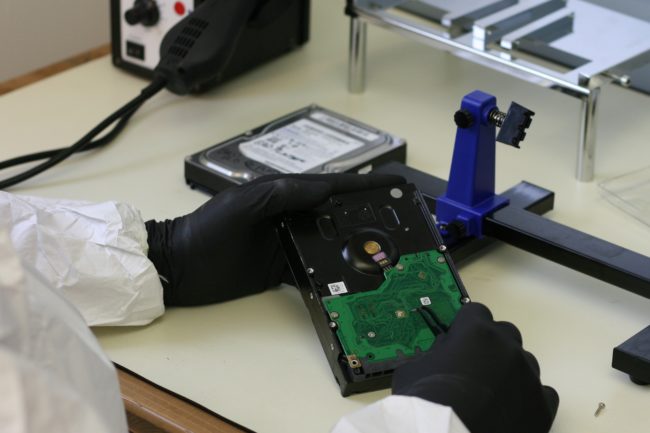How It Works
Our data recovery process is performed in two stages: diagnosis and recovery. The diagnosis stage is a free service to our customers. During the diagnosis process, we will examine your malfunctioning drive, assess the extent of the damage, estimate the total cost of recovery, and determine the amount of time necessary to recover your data.
 Step 1: Diagnosis
Step 1: Diagnosis
Several issues may be responsible for the loss of your data. Once we receive your drive, it can take us up to 72 hours to diagnose the cause of the drive’s damage.
Damage may be caused by:
Logical Drive Failure
- Logical drive failure can cause a healthy device, which has not suffered physical damage, to have files that suddenly disappear or can no longer be read by the computer. Lost files or unresponsiveness are signs of logical drive failure.
- Common causes of logical damage include removing a device preemptively without properly ejecting it, resetting your computer, a power outage while your drive is reading or writing data, accidentally formatting a drive, or drive degradation.
- Drives that have logical failure are often still operable. However, it is critical to immediately stop using your device once you become aware that your drive has suffered damage. Continued use of the drive may overwrite your data, further decreasing the chance of recovery.
Electrical Drive Failure
- Electrical drive failure occurs when a device or drive sustains damage because of a spike or surge in its electrical current.
- Common causes of electrical damage include an electrical storm, a failed power supply, or incorrectly attaching your hard drive to a power supply.
- Most modern hard drives and devices have built-in protection to prevent electrical failure. However, this protection is not a guarantee, and electrical drive failure may still occur.
Mechanical Drive Failure
- Mechanical drive failure occurs when physical damage to a device’s hard drive causes the entire drive, or certain parts of the drive, to become inoperable. Unusual noises such as clicking and inconsistent drive speeds are signs of mechanical damage.
- Common causes of mechanical damage include the impact of a drop when the device is either turned on or off, rapid movement while the device is turned on, advanced age of the device, or a manufacturing defect.
- Device hard drives have many moving parts, such as motors, read/write heads, platters, and magnets. A failure in any one of these parts may cause the entire drive to become inoperable.
Step 2: Recovery
After the free diagnosis stage of our recovery process, we will send you a summary of our findings with a diagnostic report, price quote, and timeline.
- Diagnostic Report – Our diagnostic report is free of charge to our customers. The report will explain the type of damage sustained by your drive, whether it is fully recoverable, partly recoverable, or damaged beyond repair, and the actions needed to recover the data.
- Price Quote – Our pricing guidelines for data recovery vary. This applies to all devices. Additional fees may apply if your device has suffered electrical or mechanical failure, in order to cover replacement parts that may be necessary to recover your data.
- Timeline – Additional time may be required for devices suffering from electrical or mechanical failure, in order to source and install any necessary replacement parts. Expedited services are available at additional cost.
Once your data has been recovered, we will extract a copy of the data and place it on our in-house server. We will send you an invoice, and once payment is received, the data will be delivered to you either by an FTP download link, or a replacement drive/hardware (at an additional cost). The damaged drive/device can be mailed back to you or recycled free of charge.